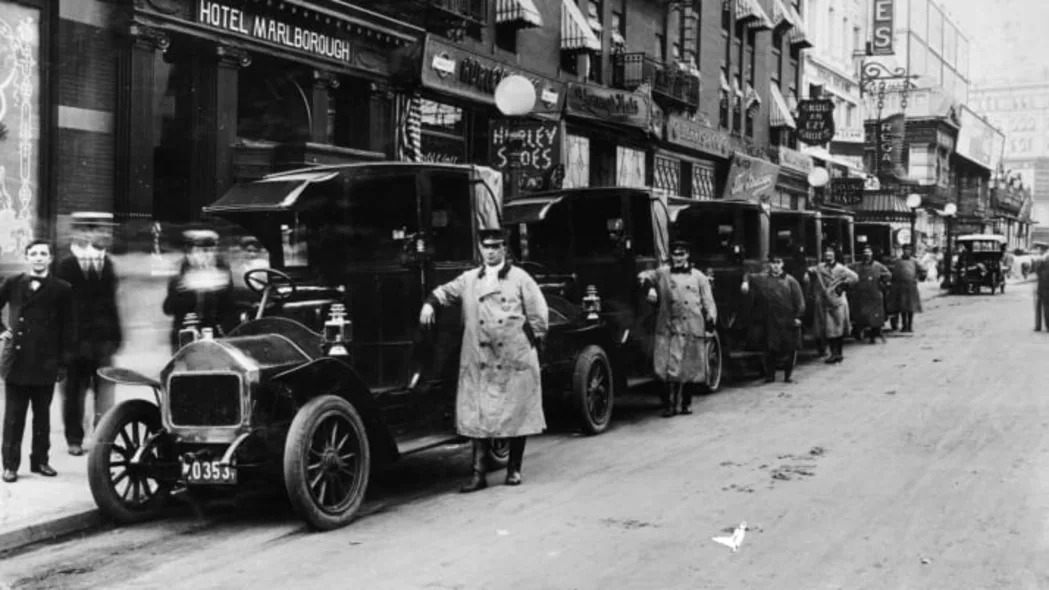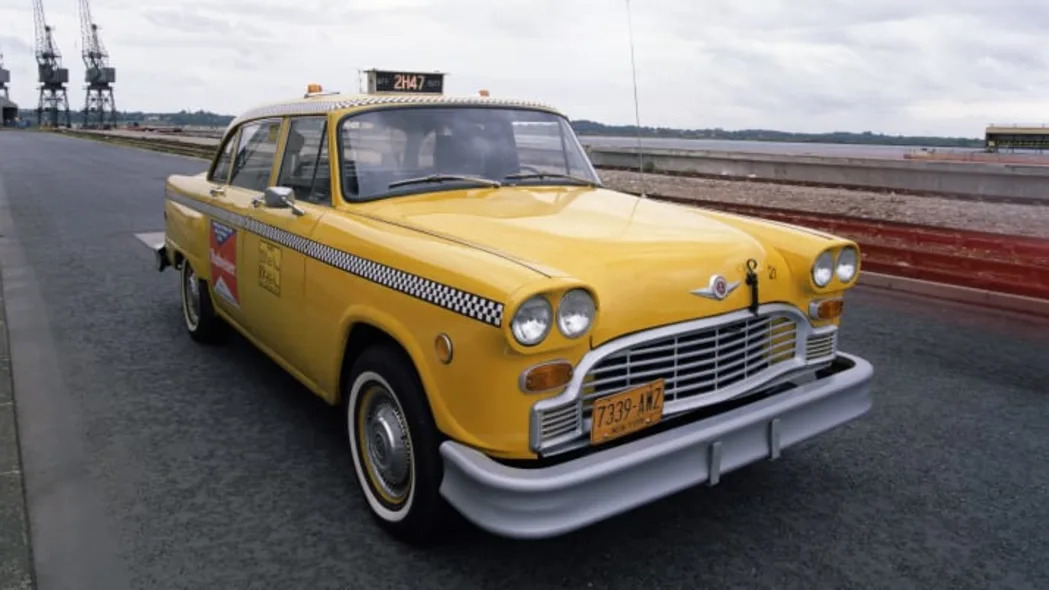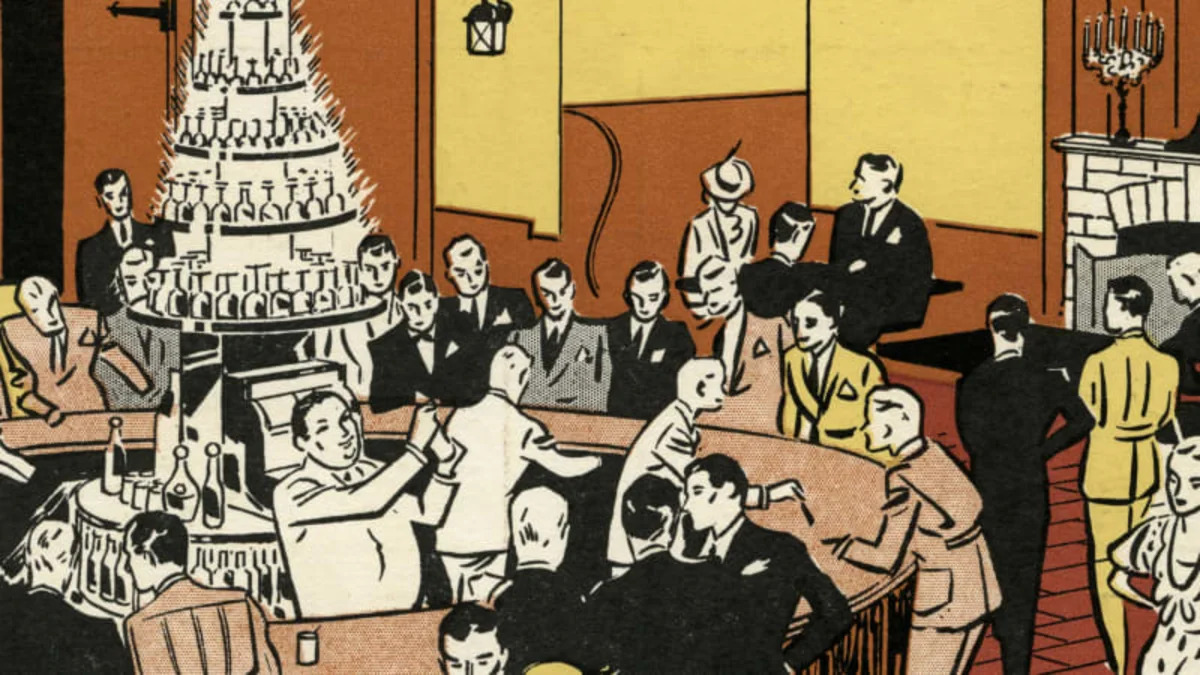In our last installment of the irregular and irreverent series on drinks loosely connected to – or named after – automobiles, we quaffed a Bentley Cocktail which in its original form tasted something like antifreeze, except worse. This time, we explore the fascinating history of the Taxi, and the adventurous experience of drinking one. And, as always, enjoy cocktails (and reading about them) while you're not behind the wheel.
The New York Taxi, that creaky, vomit-inducing conveyance that we drinky City dwellers have long relied upon to take us home from the bar, is, sadly, a species in decline. According to recent reports, taxi hails are way down, their thunder stolen by cheap Über rides, which we all know are subsidized by venture capital money in an attempt to hog market share and await the profits of the autonomous revolution, should it ever arrive.
Will you drink to the cab's demise? Or toast to its revival? If you were thumbing through 1913's classic Jacques Straub's Manual of Mixed Drinks, like we do every day at work (we write about alcohol!), you might. Because you'd have spotted a drink called The Taxi. Equal parts gin and dry vermouth, and equal (but much smaller) parts lime and absinthe, this cocktail was first penned by Straub, the famed wine steward at Chicago's elegant Blackstone Hotel. As always in "Drinking, and Driving," its discovery led us to wonder why it exists, and from whence its automotive connection derives? And, as always, our intrepid investigative skills, and panel of drunken experts, provide assistance.
Opening from a somewhat skeptical position is Playboy cocktail columnist Alyson Sheppard. "When bartenders create cocktails, they usually give them odd names so drinkers remember them," Sheppard claims. "Taxi sounds generic to us today, but in the 1910s, when the Taxi Cocktail was created, the word taxi had only just entered the lexicon. A bartender in this time period probably found 'taxi' to be novel, so he slapped it on one of his creations even though the ingredients had nothing to do with cabs."

Sheppard has a decent, etymological point. The concept of a for-hire chauffeur-driven vehicle probably dates back to the invention of the wagon, but it wasn't until the 19 th century that the mechanization of motivational power and distance measurement resulted in the invention of the Taximeter, a mechanical device that measured distance or time traveled. The word is French, combining the words taxer (to tax) and mètre (an instrument for measuring), but a German invented it. The Taxi, a synecdochal nickname for the vehicle in which it was mounted, first came to America (and our language) via a slew of French Darracq cabs (pictured above, next to the dour men in aprons) imported by New York businessman Harry N. Allen in 1907. Other big cities like Chicago followed suit.
But while we enjoy expository conjecture from our bartenders on most topics, this answer seemed a bit loosey-goosey to us. Straub was one of the best-respected libationists of his era, and his esteem remains high today. We don't think he picked the name solely because it was catchy. We decided to keep drinking, and keep looking for answers.
Our first deep hint came from cocktail historian Marco Dionysos, who underscored for us the significance of one of the key ingredients. "The Taxi resembles a 50-50 Martini—a Martini that's equal parts gin and vermouth, an atypical ratio even in the Twenties when it was more two-to-one—with the addition of a little lime and absinthe," Dinysos says. "The interesting thing here is that absinthe was banned in America in 1912, but Straub's book didn't come out until 1913. Maybe the ban on absinthe put the brakes on the Taxi's popularity before it could take off?"
With our rotted-wormwood minds stuck on this wormhole, we decided that we needed to call in an expert. Enter Lance Winters, master distiller at St. George Spirits in California, and the creator of the first legal American absinthe, released after the ban was finally lifted in 2007.
"Back at the time when this cocktail came into being, you have to remember that gins were a bit more medicinal in their profile. So getting a little more feature from an absinthe was a great direction to go," Winters says. "And because absinthe is distilled with botanicals that have oils from the anethole family—from anise seed, fennel, that licorice quality—you also get a sensation of sweetness without a sensation of sugar."
Absinthe, according to Winters, would have provided another kick, particularly at the time that the drink was created. "Though it was officially illegal, there were probably pockets where people had stashed some away. And that's one of the things that made it such a great ingredient. Any time you could find a place that was secretly serving it, the whole stolen sweets, forbidden fruit kind of thing makes it more alluring."

But most relevant for our discussion, oddly enough, is the color of the drink. When Harry N. Allen bought his 700 French cabs over to New York, he painted all of them red and green. But shortly thereafter, in 1909, Albert Rockwell founded a competing fleet of yellow cabs and established the Yellow Taxicab Company in Gotham in 1912. Allen painted his cars to match. By 1915, when businessman John Hertz founded the Yellow Cab Company in Chicago, this had become the transport's signature hue. The color stuck in part because it is intrinsically noticeable and in part because so few other people wanted (or still want) yellow cars. If you saw one, you knew it was a taxi.
Absinthe, in the mind of most people who have obsessed over French Bohemianism, is a radiant, almost radioactive, green, like a contemporary Mercedes-AMG or a fin-de-siècle Pucker. But this is not true for quality product. "It can commercially have kind of a green tint," Winters says. "But when it's made with natural ingredients, when it's colored naturally, that color tends to go more to a pale yellow or yellow/green hue. So there's a really good case to be made for that coloring being given why it was named the taxi."
Another option? "It could be that after a couple of these, that's what you needed to call to get home," Winters says. "You've been practicing ordering a Taxi for three hours when you're drinking these things, it's going to be very easy to get home at that point."
As part of our typical practice, we made the drink—using a bottle of St. George's Absinthe. Despite Winter's suggestions, it was at once medicinal and sweet, like a margarita infused with Blackjack chewing gum. A more herb-forward gin might have helped, or maybe some rosemary oil for a balancing chlorophyllic astringence. (The second one went down easier; go figure.)
So we asked one more expert, Tokyo based cocktail writer Nick Coldicott, how he would improve it. Working with legendary mixologist Hidetsugu Ueno from the Ginza district's Bar High Five—consistently ranked as one of the world's best bars—he came up with a fix. "We both thought it might be a bit more refreshing with lemon instead of lime, as would most cocktails. And when Ueno made one it seemed really obvious that whoever made the Taxi recipe should've tried it with lemon, it's much better," Coldicott says. (Yellower too.)
"Somehow it all ties together better with lemon. Let's call it The Uber."
Related Video:
The New York Taxi, that creaky, vomit-inducing conveyance that we drinky City dwellers have long relied upon to take us home from the bar, is, sadly, a species in decline. According to recent reports, taxi hails are way down, their thunder stolen by cheap Über rides, which we all know are subsidized by venture capital money in an attempt to hog market share and await the profits of the autonomous revolution, should it ever arrive.
Will you drink to the cab's demise? Or toast to its revival? If you were thumbing through 1913's classic Jacques Straub's Manual of Mixed Drinks, like we do every day at work (we write about alcohol!), you might. Because you'd have spotted a drink called The Taxi. Equal parts gin and dry vermouth, and equal (but much smaller) parts lime and absinthe, this cocktail was first penned by Straub, the famed wine steward at Chicago's elegant Blackstone Hotel. As always in "Drinking, and Driving," its discovery led us to wonder why it exists, and from whence its automotive connection derives? And, as always, our intrepid investigative skills, and panel of drunken experts, provide assistance.
Opening from a somewhat skeptical position is Playboy cocktail columnist Alyson Sheppard. "When bartenders create cocktails, they usually give them odd names so drinkers remember them," Sheppard claims. "Taxi sounds generic to us today, but in the 1910s, when the Taxi Cocktail was created, the word taxi had only just entered the lexicon. A bartender in this time period probably found 'taxi' to be novel, so he slapped it on one of his creations even though the ingredients had nothing to do with cabs."

Sheppard has a decent, etymological point. The concept of a for-hire chauffeur-driven vehicle probably dates back to the invention of the wagon, but it wasn't until the 19 th century that the mechanization of motivational power and distance measurement resulted in the invention of the Taximeter, a mechanical device that measured distance or time traveled. The word is French, combining the words taxer (to tax) and mètre (an instrument for measuring), but a German invented it. The Taxi, a synecdochal nickname for the vehicle in which it was mounted, first came to America (and our language) via a slew of French Darracq cabs (pictured above, next to the dour men in aprons) imported by New York businessman Harry N. Allen in 1907. Other big cities like Chicago followed suit.
But while we enjoy expository conjecture from our bartenders on most topics, this answer seemed a bit loosey-goosey to us. Straub was one of the best-respected libationists of his era, and his esteem remains high today. We don't think he picked the name solely because it was catchy. We decided to keep drinking, and keep looking for answers.
Our first deep hint came from cocktail historian Marco Dionysos, who underscored for us the significance of one of the key ingredients. "The Taxi resembles a 50-50 Martini—a Martini that's equal parts gin and vermouth, an atypical ratio even in the Twenties when it was more two-to-one—with the addition of a little lime and absinthe," Dinysos says. "The interesting thing here is that absinthe was banned in America in 1912, but Straub's book didn't come out until 1913. Maybe the ban on absinthe put the brakes on the Taxi's popularity before it could take off?"
With our rotted-wormwood minds stuck on this wormhole, we decided that we needed to call in an expert. Enter Lance Winters, master distiller at St. George Spirits in California, and the creator of the first legal American absinthe, released after the ban was finally lifted in 2007.
"Back at the time when this cocktail came into being, you have to remember that gins were a bit more medicinal in their profile. So getting a little more feature from an absinthe was a great direction to go," Winters says. "And because absinthe is distilled with botanicals that have oils from the anethole family—from anise seed, fennel, that licorice quality—you also get a sensation of sweetness without a sensation of sugar."
Absinthe, according to Winters, would have provided another kick, particularly at the time that the drink was created. "Though it was officially illegal, there were probably pockets where people had stashed some away. And that's one of the things that made it such a great ingredient. Any time you could find a place that was secretly serving it, the whole stolen sweets, forbidden fruit kind of thing makes it more alluring."

But most relevant for our discussion, oddly enough, is the color of the drink. When Harry N. Allen bought his 700 French cabs over to New York, he painted all of them red and green. But shortly thereafter, in 1909, Albert Rockwell founded a competing fleet of yellow cabs and established the Yellow Taxicab Company in Gotham in 1912. Allen painted his cars to match. By 1915, when businessman John Hertz founded the Yellow Cab Company in Chicago, this had become the transport's signature hue. The color stuck in part because it is intrinsically noticeable and in part because so few other people wanted (or still want) yellow cars. If you saw one, you knew it was a taxi.
Absinthe, in the mind of most people who have obsessed over French Bohemianism, is a radiant, almost radioactive, green, like a contemporary Mercedes-AMG or a fin-de-siècle Pucker. But this is not true for quality product. "It can commercially have kind of a green tint," Winters says. "But when it's made with natural ingredients, when it's colored naturally, that color tends to go more to a pale yellow or yellow/green hue. So there's a really good case to be made for that coloring being given why it was named the taxi."
Another option? "It could be that after a couple of these, that's what you needed to call to get home," Winters says. "You've been practicing ordering a Taxi for three hours when you're drinking these things, it's going to be very easy to get home at that point."
As part of our typical practice, we made the drink—using a bottle of St. George's Absinthe. Despite Winter's suggestions, it was at once medicinal and sweet, like a margarita infused with Blackjack chewing gum. A more herb-forward gin might have helped, or maybe some rosemary oil for a balancing chlorophyllic astringence. (The second one went down easier; go figure.)
So we asked one more expert, Tokyo based cocktail writer Nick Coldicott, how he would improve it. Working with legendary mixologist Hidetsugu Ueno from the Ginza district's Bar High Five—consistently ranked as one of the world's best bars—he came up with a fix. "We both thought it might be a bit more refreshing with lemon instead of lime, as would most cocktails. And when Ueno made one it seemed really obvious that whoever made the Taxi recipe should've tried it with lemon, it's much better," Coldicott says. (Yellower too.)
"Somehow it all ties together better with lemon. Let's call it The Uber."
The Taxi
½ Jigger French Vermouth
½ Jigger Dry Gin
2 Barspoonfuls lime juice
2 Barspoonfuls Absinthe
Serve "Frappe"
TheUber Lyft (Thanks to Hidetsugu Ueno)
½ Jigger French Vermouth
½ Jigger Dry Gin
2 Barspoonfuls lemon juice
2 Barspoonfuls Absinthe
Serve "Frappe"
½ Jigger French Vermouth
½ Jigger Dry Gin
2 Barspoonfuls lime juice
2 Barspoonfuls Absinthe
Serve "Frappe"
The
½ Jigger French Vermouth
½ Jigger Dry Gin
2 Barspoonfuls lemon juice
2 Barspoonfuls Absinthe
Serve "Frappe"
Related Video:


Sign in to post
Please sign in to leave a comment.
Continue